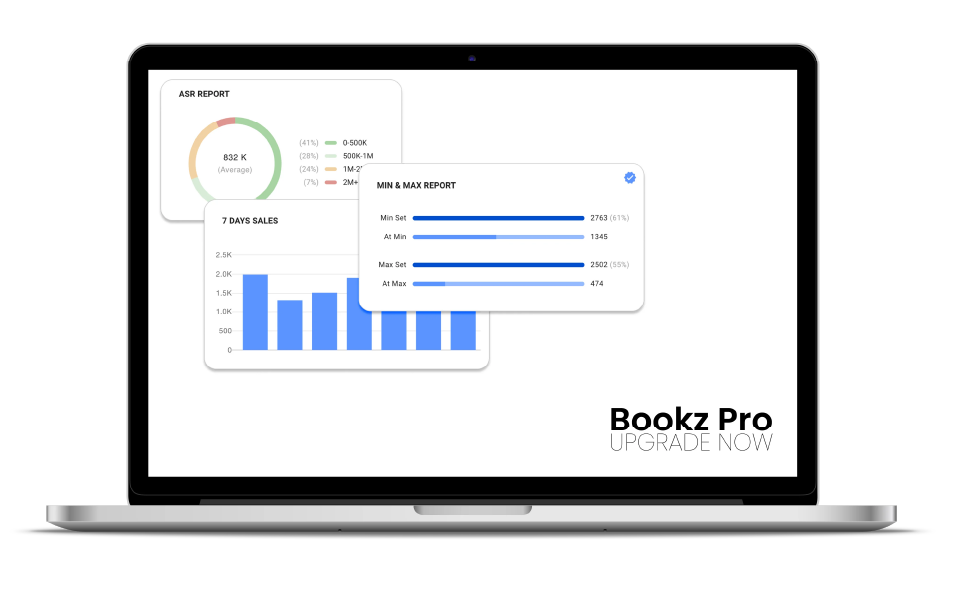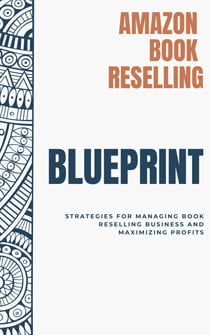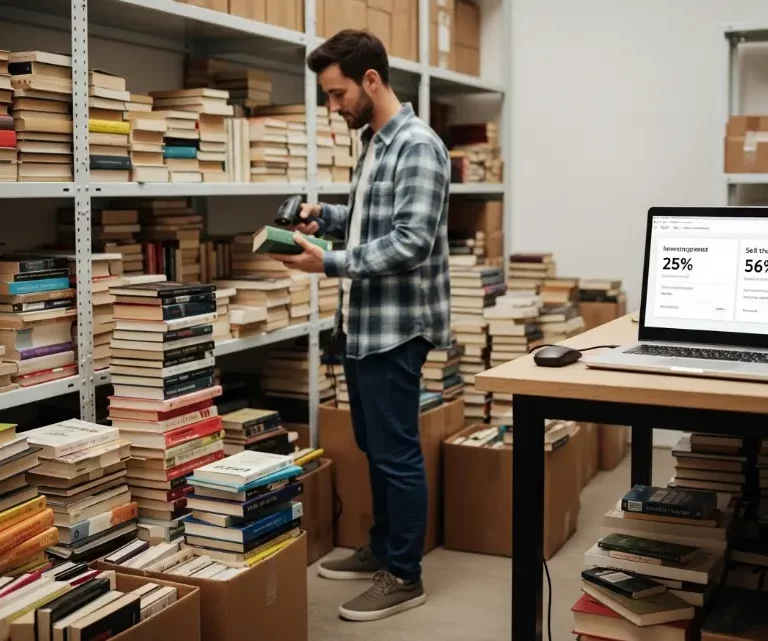Book Scanning Mistakes That Waste Hours — And the Simple Fix

When book scanning, most book sellers spend three hours at Goodwill just to walk out with one sad $8 winner. Sound familiar?
There’s always someone leaving with a cart full of valuable books while others find nothing. The difference isn’t luck—it’s knowing where to look and asking the one question that saves half your scanning time.
The secret? One specific question that flips results overnight, plus knowing which sections to completely skip (even when they look tempting) and where the real money actually hides.
At the end of this blog, you will learn to change your mindset and start strategizing better to get the right and profitable books.
1. Scanning the Same Inventory Repeatedly
One of the biggest mistakes new sellers make when book scanning is wasting time on the same inventory over and over. Most thrift stores, Goodwill, and Half Price Books don’t restock shelves daily. Instead, they rotate inventory on a schedule, usually marked with color-coded stickers or tags.
Here’s the problem: if you don’t know the code, you’ll keep scanning books that have been sitting there for weeks. That means hours of effort with almost no new finds—time that could’ve been spent sourcing real profit.
How to Fix It
The solution is simple: ask the manager.
Walk up and say, “What’s the current color code for new arrivals?” That one question can completely change your results. If the store tells you this week’s books are marked with yellow stickers, you now know exactly where to focus.
Instead of scanning thousands of old titles, you can zero in on the fresh stock—the books with the highest chance of flipping for a profit.
Why This Works
- Saves hours: You stop wasting time on inventory you’ve already scanned.
- Boosts profit potential: Fresh books mean better chances of finding hidden gems.
- Streamlines your workflow: You only spend time where it counts.

2. Wasting Time in Low-Profit Sections
Don’t work harder than you need to. By learning your local store’s rotation system, you’ll spend less time scanning and walk away with a more profitable cart. Efficiency is the real advantage in book sourcing.
Here’s the hard truth: not every book in a thrift store is worth your time. In fact, whole sections are filled with titles that almost never sell for profit on Amazon.
Children’s books, mass-market thrillers, and popular fiction might look like easy wins because they’re everywhere—but most of them are what resellers call “penny books.” That means they’re so common on Amazon that they sell for a dollar or less, often not even covering fees. You could scan 200 of these titles and walk away with nothing valuable.
This is the solution for it:
Instead of wasting time on low-profit sections, skip them altogether. Your goal isn’t to scan every single book in the store—it’s to scan the right books.
Focus on categories that consistently deliver profits:
- Non-fiction – biographies, history, self-help, and niche topics hold long-tail value.
- Cookbooks – especially specialty diets, regional cuisines, or out-of-print editions.
- Textbooks – even older editions often resell well for students.
- Academic titles – research, science, and reference materials rarely flood the market.
These categories may not fill entire shelves, but they yield higher margins and fewer wasted scans.
Why This Works
- More profit per scan: You’re targeting categories that actually sell for $15, $30, or even $80+.
- Less wasted effort: Instead of scanning hundreds of penny books, you’re filtering for quality.
- Higher hourly rate: By focusing on profitable niches, you boost your earnings without increasing your time.
All in One Software
for Book Sellers
Scout Better – List Faster – Reprice Smarter
Over 30% Business Growth
Achieved by Our Clients

3. Using Inefficient Scanning Methods
If you’re still relying on your phone camera and free apps to scan books, you’re slowing yourself down more than you realize. While it might seem “good enough” when you’re just starting out, this method is clunky, slow, and often misses the data that actually matters.
Think about it: every extra second spent waiting for your camera to focus or an app to load is time you could’ve spent scanning the next profitable book. Multiply that by hundreds of scans, and suddenly you’ve lost hours. Worse, free apps often leave out key information like real-time sales rank, FBA pricing, or profit calculations—meaning you could be passing on valuable books without even knowing it.
Best way to resolve this
Upgrade your setup with a Bluetooth scanner paired with a professional scouting app like Bookzy Mobile. This combination is the gold standard for serious book sellers.
Here’s why:
- Speed: A Bluetooth scanner reads barcodes instantly, letting you fly through shelves without lag.
- Accuracy: Professional apps like Bookzy Mobile give you live data—sales rank, buy box price, FBA competition, and true profit margins.
- Efficiency: Instead of guessing, you make fast, informed decisions on every book.
Note:
Scanning with just your phone: maybe 300-400 books per hour.
Scanning with a Bluetooth scanner + pro app: easily 500 + books per hour.
If you’re serious about making money reselling books, ditch the outdated scanning methods.
The right tools don’t just make you faster—they make you smarter.
4. Not Tracking ROI Per Store
One of the most common mistakes book scanners make is treating every store the same. Too many sellers fall into the habit of going back to the same thrift shop every week without ever asking: “Is this store actually worth my time?”
Here’s the reality: not all stores deliver equal results. You might spend three hours scanning in one location only to walk away with $20 in profit, while another store across town consistently gives you $200 worth of flips in the same amount of time. If you’re not tracking your ROI (Return on Investment) per store, you’re flying blind.
Why This Matters
Time is your most valuable resource. By revisiting low-yield stores over and over, you’re cutting into the hours you could be spending in higher-performing locations. Even if you love the familiarity of one store, if the math doesn’t add up, it’s costing you profit.
How can you fix it?
Start tracking your results by store. It doesn’t have to be complicated—just note down:
- How much time you spent scanning
- How many books you purchased
- Your projected profit from that haul
After a few weeks, patterns will emerge. You’ll quickly see which stores are worth keeping in your rotation and which ones consistently underperform.
Pro Tip: Rotate High-Performing Stores
Instead of hitting the same low-yield store every Saturday, build a rotation of high-ROI locations. By spreading your time across multiple profitable stores, you maximize your sourcing efficiency and avoid wasting energy where returns are weak.
Book sourcing isn’t just about finding profitable books—it’s about knowing where your time pays off the most. Track ROI per store, double down on the winners, and cut back on the duds. That one shift can easily double your weekly profits without adding more hours.

5. Overvaluing Effort Instead of Efficiency
A lot of new book scanners make the mistake of believing that more effort automatically equals more profit. They spend entire weekends scanning every single shelf, thinking the harder they work, the bigger their payout will be. But here’s the truth: book scouting doesn’t reward sweat—it rewards strategy.
You could spend six hours scanning thousands of low-value books and walk out with a handful of small flips. Or, you could spend just two hours with a targeted, efficiency-first approach and come home with a cart full of $20–$50 profit books. The difference isn’t effort—it’s focus.
Here’s how you can do it:
Instead of asking “How many books did I scan today?” start asking “What was my profit per hour?” That’s the metric that really matters. Every choice you make—from the shelves you skip, to the tools you use, to the questions you ask staff—should point back to maximizing your return for the time invested.
Here’s what an efficiency-first mindset looks like:
- Skip low-value sections (like mass-market fiction) and zero in on high-profit categories.
- Use professional tools—Bluetooth scanners and scouting apps like Bookzy Mobile —to move faster and smarter.
- Leverage store systems—like color codes for new inventory—so you’re never rescanning stale stock.
- Track ROI by store to focus only on locations that give you the best results.
Why This Matters?
When you shift from effort to efficiency, you stop burning yourself out and start treating book scouting like a real business. The goal isn’t to scan the most books—it’s to make the most money in the least amount of time.
Stop Wasting Time on These Money-Pit Sections
The brutal truth: Most sections are complete wastes of time
Skip these (the time-wasters):
- Kids books → mostly penny books on Amazon
- Romance novels → everyone’s selling them
- Beat-up paperback thrillers → oversaturated market
- Anything that looks trashed
Focus here instead (the money makers):
- Cookbooks (especially specialty/ethnic cuisine)
- Business and self-help books
- College textbooks and study guides
- Art and photography books
- Anything that looks expensive or academic
The 80/20 rule: 80% of your profits come from 20% of book categories
Book scanning doesn’t have to be slow. Bookz Pro makes it simple.

Amazon Book Reselling Blueprint
Read now, explore our full guide. Your revolution starts here. Subscribe to get the blueprint!
Most booksellers waste hours every weekend rescanning the same shelves, draining their phone battery, and ending up with stacks of penny books that barely cover fees. It’s frustrating, exhausting, and not worth your time. Bookz Pro changes that. With fast scanning, real profit data, and smart tools built for booksellers, you’ll cut out the guesswork and zero in on books that actually make money. No more wasted hours—just smarter sourcing and higher profits.
Start your free 14-day trial and unlock the Amazon Book Reselling Blueprint—filled with sourcing tips and pricing strategies. Whether you’re thrifting or buying in bulk, Bookz Pro makes it easy to turn your finds into steady Amazon profits.
Conclusion
Book scouting doesn’t reward the hours you put in—it rewards the strategy you bring to the shelves. If you keep rescanning old inventory, wasting time in low-profit sections, and relying on slow tools, you’ll only scrape by. But if you focus on efficiency—learning store systems, targeting profitable categories, upgrading your setup, and tracking ROI—this side hustle can deliver real returns.
Stop grinding harder and start working smarter. That shift is what separates frustrated scanners from profitable sellers.
Frequently Asked Questions
Book scanning is the process of using a phone app or Bluetooth scanner to check a book’s barcode against Amazon’s database. This reveals key details like sales rank, price, and potential profit so resellers can quickly decide if a book is worth buying to resell.
Most scanners waste time rescanning old inventory, scanning low-profit sections like kids’ books and thrillers, or relying on slow phone apps. Without a clear system, hours of effort often return only a handful of low-value books.
The fastest way is to use a Bluetooth scanner paired with a professional scouting app like Bookzy Mobile. This combo lets you scan over 500 books per hour, compared to other book scouting apps that scan 100-200 books with just a phone camera. It also gives you real-time profit data.
Ask store staff about their color-coded rotation system for new arrivals. By focusing only on fresh inventory, you skip stale shelves and dramatically increase your chances of finding profitable flips.
No. Success in book reselling isn’t about volume—it’s about efficiency. Scanning thousands of penny books wastes time, while targeting profitable niches boosts your profit per hour without burning out.



